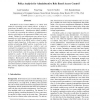Free Online Productivity Tools
i2Speak
i2Symbol
i2OCR
iTex2Img
iWeb2Print
iWeb2Shot
i2Type
iPdf2Split
iPdf2Merge
i2Bopomofo
i2Arabic
i2Style
i2Image
i2PDF
iLatex2Rtf
Sci2ools
CSFW
2006
IEEE
2006
IEEE
Policy Analysis for Administrative Role Based Access Control
Role-Based Access Control (RBAC) is a widely used model for expressing access control policies. In large organizations, the RBAC policy may be collectively managed by many administrators. Administrative RBAC (ARBAC) is a model for expressing the authority of administrators, thereby specifying how an organization’s RBAC policy may change. Changes by one administrator may interact in unintended ways with changes by other administrators. Consequently, the effect of an ARBAC policy is hard to understand by simple inspection. In this paper, we consider the problem of analyzing ARBAC policies, in particular to determine reachability properties (e.g., whether a user can eventually be assigned to a role by a group of administrators) and availability properties (e.g., whether a user cannot be removed from a role by a group of administrators) implied by a policy. We first establish the connection between security policy analysis and planning in Artificial Intelligence. Based partly on this ...
| Added | 10 Jun 2010 |
| Updated | 10 Jun 2010 |
| Type | Conference |
| Year | 2006 |
| Where | CSFW |
| Authors | Amit Sasturkar, Ping Yang, Scott D. Stoller, C. R. Ramakrishnan |
Comments (0)

